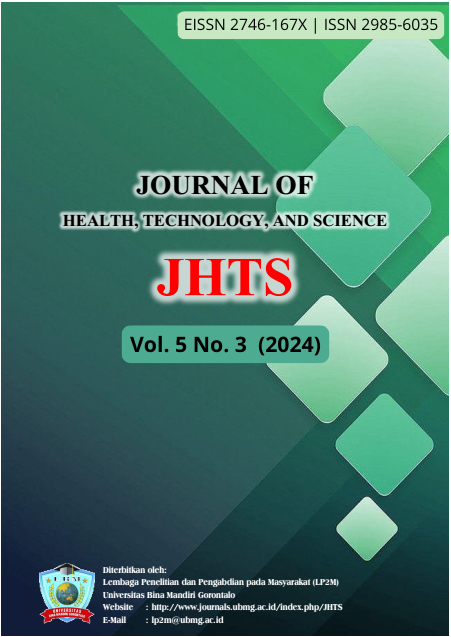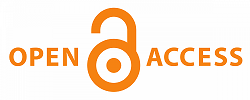COMPARISON OF BLEEDING TIME (BT) TEST RESULTS OF DUKE METHOD AND IVY METHOD IN PREOPERATIVE PATIENTS AT MM HOSPITAL. DUNDA LIMBOTO
Abstract
Bleeding Time (BT) is a laboratory test to determine the length of time the body stops bleeding due to trauma made in a laboratory manner. This test measures hemostasis and coagulation. The coagulation factor will be activated to form fibrin threads that make platelet plugs stable, therefore bleeding can be stopped. The purpose of this study was to see the comparison of the results of the bleeding time examination of the Duke method and the Ivy method. The method in this study uses a quantitative approach with a cross sectional approach. The sampling technique in this study used accidental sampling technique, assuming a total sample of 24 samples. Using univariate data analysis techniques processed through the IBM SPSS Statistic V25.0 program. The results showed that in the Duke method there were 23 respondents (95.8%) who were normal, there was only 1 respondent (4.2%) whose results were abnormal. While the results of research using the ivy method obtained the results of all 24 respondents (100%) showed normal results. Based on the Independent T Test, it can be seen that p-value = 0.000< (α) 0.05 shows that there is a significant difference between the results of bleeding time examination using the Duke method and the ivy method in preoperative patients.
References
2. The results of the study using the ivy method obtained the results of all 24 respondents (100%) showed normal results.
3. Based on the Independent T Test, it can be seen that p-value = 0.000 < (α) 0.05 shows that there is a significant difference between the results of bleeding time examination using the Duke method and the ivy method in preoperative patients.
REFERENCES
[1] Aliviameita, A & Puspitasari. (2019). Buku Ajar Hematologi. UMSIDA Press. Sidoarjo.
[2] Arif, M. (2018). Penuntun Praktikum Hematologi. Fakultas Kedokteran Universitas Hasanuddin. Makassar.
[3] Bakta. 2019. Hematologi Klinik Ringkas. Jakarta: EGC.
[4] Durachim, A. Astuti, D. (2018). Bahan Ajar Teknologi Laboratorium Medik : Hemostasis. Badan Pengembangan Dan Pemberdayaan Sumber Daya Manusia Kesehatan. Pusat Pendidikan Sumber Daya Manusia. Kementerian Kesehatan RI. Jakarta.
[5] Depkes RI. 2019. Pedoman Pengambilan, Penyimpanan, Pengemasan dan Pengiriman Spesimen Darah
[6] Firani, N. K. (2018). Mengenali Sel-Sel Darah dan Kelainan Darah. Universitas Brawijaya Press. Malang
[7] Handayani, Hariwibowo. 2020. Asuhan Keperawatan pada Klien dengan Gangguan Sistem Hematologi. Salemba Medika. Jakarta.
[8] Nugraha, G. (2019). Panduan Pemeriksaan Laboratorium Hematologi Dasar. Trans Info Medika. Jakarta.
[9] Notoadmojo, Soekidjo. (2018). Metodologi Penelitian Kesehatan. Rineka Cipta. Jakarta.
[10] Nugraha, G & Badrawi, Imaduddin. (2020). Pedoman Teknik Pemeriksaan Laboratorium Klinik Untuk Mahasiswa Teknologi Laboratorium Medik. Penerbit : Trans Info Media. Jakarta.
[11] Rinaldi, I. (2019). Modul Hematologi – Onklogi : Hemostasis. Universitas Indonesia. Jakarta.
[12] Spreckhelsen, V T. Chalil, M, JA. (2021). Tingkat Kecemasan Preoperatif Pada Pasien Yang Akan Menjalani Tindakan Anastesi Pada Operasi Elektif. Jurnal Ilmiah Kohesi Vol. 5 No. 4 Oktober 2021. Diakses pada 05 Februari 2023.
[13] Sjamsuhidajat R, De Jong W, Editors. (2018). Buku Ajar Ilmu Bedah Sistem Organ dan Tindak Bedahnya 4th ed. Penerbit Buku Kedokteran EGC. Jakarta.
[14] Sugiyono. 2019. Metode Penelitian Kuantitatif, Kualitatif, dan R & D. Penerbit : CV. Alfabeta. Bandung.
[15] Sudjana. 2019. Metode Statistika. PT. Tarsito. Bandung.
[16] Siregar, Maria T. Wulan, Wieke S. Setiawan Doni, Nuryati, Anik. (2018). Bahan Ajar Teknologi Laboratorium Medik : Kendali Mutu. Badan Pengembangan Dan Pemberdayaan Sumber Daya Manusia Kesehatan. Pusat Pendidikan Sumber Daya Manusia. Kementerian Kesehatan RI. Jakarta.
[17] Ubaidillah, Z. (2020). Modul Sistem Imun Dan Hematologi. Program Studi S-1 Keperawatan Stikes Hafshawaty Zainul Hasan Genggong. Probolinggo.
Copyright (c) 2024 Dwi Cahyani Amalia Ismail, Muh. Rizman Naim, Erfan AR. Lainjong

This work is licensed under a Creative Commons Attribution 4.0 International License.













